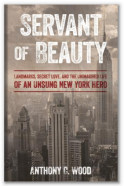
Laurel Lovrek
The professors of architecture at Cooper Union encouraged then-student Laurel Lovrek to be active in the demonstrations against the demolition of Pennsylvania Station.
As a young architecture student, Laurel Lovrek joined the picket-line protest against the demolition of Penn Station organized by the Action Group for Better Architecture in New York (AGBANY) in August 1962. In this brief interview, conducted by Annette Rosen in conjunction with the New York Preservation Archive Project’s commemoration of the 40th anniversary of the station’s destruction, Lovrek describes her experience of the protest and the influence it had on her later professional career.
Lovrek: Hi, I’m Laurel Lovrek.
Q: I’m Annette Rosen, and I’m going to ask you how you became involved in the effort to save Penn Station.
Lovrek: I was a student at Cooper Union. Starting in 1962, Chet Wisniewski, who taught “Architect Talks,” which is a class given to art students and architects, sent us down to Penn Station with pads of newsprint to draw what we saw there. I didn’t realize what was going on, being new to New York, and really new to architecture, but I fell in love with the building. I really felt that it was almost a monument to travel and the importance of the individual during their daily life.
Later, in my sophomore year, our professor, Lew Davis, asked our whole class to participant in the demonstration. That was the one that was commemorated tonight. We did participate, and went down there and picketed. What I remember about that day is the indifference of people on the street to the message that we were trying to communicate. I also remember seeing, when the new Penn Station/Madison Square Garden went up, the cultural abyss that replaced what was there.
As a student, I learned that one of the driving forces of architecture was money. For a young, idealistic person, who was very interested in modern architecture, it taught me two lessons. It taught me the value of money, and it also pointed out that what was new was not necessarily better. That was my experience.
Q: Tell me, did you get involved in any other, further preservation efforts?
Lovrek: Later, in my career as an architect, I worked on some projects that involved preservation. I can’t say that I’ve led any movements, but I think my earlier experience with Penn Station sensitized me to the value of treating those structures—in one case, even a historical farm—with a reverence for what had gone before. For cultivating that and preserving it in the flow of time, for other people in the future, so they could see what was there and not have it destroyed.
Q: That was a very valuable lesson to have learned and to try to impart to others. Tell me, what did you feel the impact of the loss of Penn Station was on New York City?
Lovrek: I think it cheapened the city. It demonstrated a lack of value for cultural and aesthetic treasures. At least for me, if I were a commuter, I would have missed that space. I know that when I emerge from New Jersey, up into the tunnel there, it is not the experience of arrival, it’s just a run through the rat maze.
Q: I thank you very much for your forceful remarks, and thank you for coming to offer them to us.
Lovrek: Thank you very much. It was a delightful experience.
[END OF INTERVIEW]


